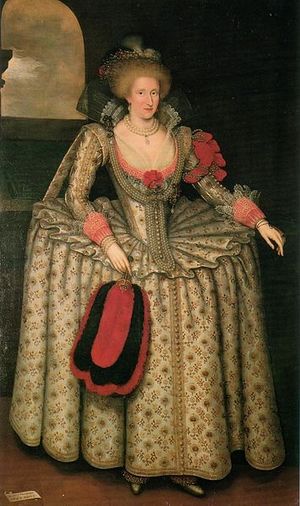Farthingale
Farthingale is a term applied to any of several structures used under Western European women's clothing in the late 15th and 16th centuries to support the skirts into the desired shape. It originated in Spain.
Spanish farthingale
The Spanish farthingale was a hoop skirt. Originally stiffened with the subtropical Giant Cane, later designs in the temperate climate zone were stiffened with osiers (willow cuttings), rope, or (from about 1580) whalebone. The name comes from the Spanish verdugo, "green wood", because the dying stems of giant cane are rigid.
French farthingale
The French Farthingale (a.k.a. Bumroll) was introduced in the late 1570s to England from France where the style originated.
There are no extant examples of this style of undergarment and only one drawing-a caricature. From contemporary references (and the visual cues provided by the caricature), it appears to have consisted of a bolster-like roll either stuffed or held out with reeds which, being fastened around the hips, served the purpose of widening the skirts at the hip area, creating the drape evident in the painting below.
Some modern customers conjecture that the French Farthingale and the Great Farthingale (discussed below) refer to one and the same garment, the difference in shape and construction is due to changes in fashion from the 1580s to the 1590s.
Great farthingale
The Great farthingale (a.k.a. The Drum or Wheel or Cartwheel or (rarely) Italian or Catherine-wheel Farthingale in modern times) is the name given to the style of farthingale that evolved from the French Farthingale discussed above, and which became fashionable in the 1590s.
Although there are also no surviving examples of this type of garment, there are a number of references to a "Great Farthingale" in Queen Elizabeth I's wardrobe accounts during the time when this style was in vogue. "Great" in this context refers to the large circumference of the farthingale which was required in order to achieve the fashionable silhouette.
The Great Farthingale appears to have been worn at an angle ("low before and high behind") which visually elongated the wearer's torso while shortening their legs. Modern costumers conjecture that it probably consisted of one or more large hoops with horizontal stiffeners which radiated from around the waist in order to produce a flat platter-like shape when supported underneath by the "bumroll" or "French Farthingale" described above.
The Great Farthingale remained in fashion into the few decades of the 17th century, mostly for Court functions, after which the fashion died out.
Chat rooms • What links here • Copyright info • Contact information • Category:Root
